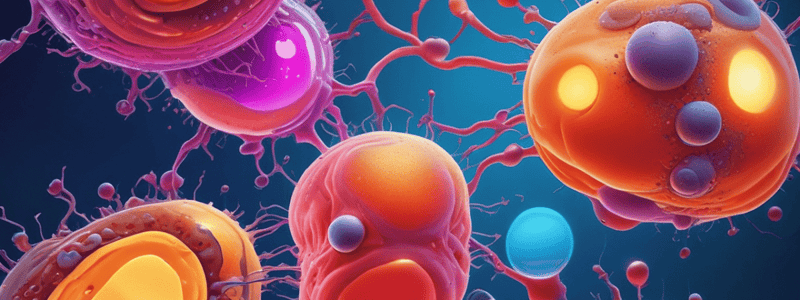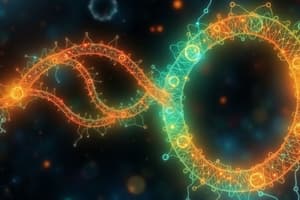Podcast
Questions and Answers
What is the main function of anabolism in the context of cellular metabolism?
What is the main function of anabolism in the context of cellular metabolism?
- Building molecules from simpler units with an input of energy (correct)
- Organizing metabolic pathways
- Breaking down complex molecules to release energy
- Managing cellular resources
Which type of process involves the breakdown of molecules into less complex units to produce energy?
Which type of process involves the breakdown of molecules into less complex units to produce energy?
- Catabolism (correct)
- Metabolism
- Anabolism
- Homeostasis
What is the primary role of metabolism in cells?
What is the primary role of metabolism in cells?
- Performing cellular functions such as moving and growing
- Breaking down cellular resources
- Encoding/transmitting information within the cell
- Managing chemical processes to produce and use energy (correct)
How are metabolic processes typically organized?
How are metabolic processes typically organized?
What is the relationship between metabolism, anabolism, and catabolism?
What is the relationship between metabolism, anabolism, and catabolism?
Which of the following is NOT a requirement for cells to function?
Which of the following is NOT a requirement for cells to function?
What is the relationship between anabolism and catabolism in the context of cellular metabolism?
What is the relationship between anabolism and catabolism in the context of cellular metabolism?
Which of the following statements about the organization of metabolic processes is MOST accurate?
Which of the following statements about the organization of metabolic processes is MOST accurate?
Which of the following is the MOST accurate definition of metabolism?
Which of the following is the MOST accurate definition of metabolism?
Which of the following is a key function of the membrane in a cell?
Which of the following is a key function of the membrane in a cell?
What is the primary function of ATP in cellular metabolism?
What is the primary function of ATP in cellular metabolism?
Which basic form of energy is associated with the movement of matter through space?
Which basic form of energy is associated with the movement of matter through space?
According to the Second Law of Thermodynamics, what happens to entropy during natural processes?
According to the Second Law of Thermodynamics, what happens to entropy during natural processes?
In energy transformations, what rule does the First Law of Thermodynamics represent?
In energy transformations, what rule does the First Law of Thermodynamics represent?
What distinguishes between kinetic and potential energy based on their definitions?
What distinguishes between kinetic and potential energy based on their definitions?
What property of a system does the entropy measure?
What property of a system does the entropy measure?
Which molecule serves as the primary energy 'currency' of the cell?
Which molecule serves as the primary energy 'currency' of the cell?
What gives the third phosphate in the ATP molecule a high potential energy?
What gives the third phosphate in the ATP molecule a high potential energy?
What process results in an increase in the entropy of a system when a solute diffuses from an area of higher concentration to lower concentration?
What process results in an increase in the entropy of a system when a solute diffuses from an area of higher concentration to lower concentration?
Which molecule is composed of a nitrogenous base, a pentose sugar, and a phosphate?
Which molecule is composed of a nitrogenous base, a pentose sugar, and a phosphate?
What role does ATP play in powering metabolic processes?
What role does ATP play in powering metabolic processes?
What is the main function of nucleotides in metabolic processes?
What is the main function of nucleotides in metabolic processes?
When ATP hydrolysis occurs, what happens to the energy released?
When ATP hydrolysis occurs, what happens to the energy released?
Which process involves the transfer of a phosphate group from ATP to other molecules?
Which process involves the transfer of a phosphate group from ATP to other molecules?
What type of energy transformation occurs when the third phosphate group in ATP is hydrolyzed?
What type of energy transformation occurs when the third phosphate group in ATP is hydrolyzed?
How does the addition of a phosphate group from ATP affect a molecule?
How does the addition of a phosphate group from ATP affect a molecule?
Which statement about ATP hydrolysis driving cellular work is correct?
Which statement about ATP hydrolysis driving cellular work is correct?
In cellular metabolism, what does the term 'phosphorylation' refer to?
In cellular metabolism, what does the term 'phosphorylation' refer to?
How does hydrolysis of the third phosphate in ATP relate to cellular processes?
How does hydrolysis of the third phosphate in ATP relate to cellular processes?
What does ATP primarily provide for cellular work?
What does ATP primarily provide for cellular work?
Which of the following best describes the relationship between the second law of thermodynamics and entropy?
Which of the following best describes the relationship between the second law of thermodynamics and entropy?
What is the primary function of ATP in cellular metabolism?
What is the primary function of ATP in cellular metabolism?
What is the relationship between the electrostatic repulsion between the phosphate groups in ATP and the potential energy of the molecule?
What is the relationship between the electrostatic repulsion between the phosphate groups in ATP and the potential energy of the molecule?
What is the primary role of nucleotides in metabolic processes?
What is the primary role of nucleotides in metabolic processes?
What is the relationship between anabolism and catabolism in the context of cellular metabolism?
What is the relationship between anabolism and catabolism in the context of cellular metabolism?
What is the primary role of the cell membrane in cellular metabolism?
What is the primary role of the cell membrane in cellular metabolism?
What type of energy transformation occurs when the third phosphate group in ATP is hydrolyzed?
What type of energy transformation occurs when the third phosphate group in ATP is hydrolyzed?
What is the main function of phosphorylation in cellular metabolism?
What is the main function of phosphorylation in cellular metabolism?
What type of energy transformation occurs when the third phosphate group in ATP is hydrolyzed?
What type of energy transformation occurs when the third phosphate group in ATP is hydrolyzed?
What is the primary role of ATP hydrolysis in cellular work?
What is the primary role of ATP hydrolysis in cellular work?
How does the addition of a phosphate group from ATP affect the structure and function of a molecule?
How does the addition of a phosphate group from ATP affect the structure and function of a molecule?
What is the relationship between anabolism and catabolism in the context of cellular metabolism?
What is the relationship between anabolism and catabolism in the context of cellular metabolism?
What is the main function of ATP in cellular metabolism?
What is the main function of ATP in cellular metabolism?
What gives the third phosphate in the ATP molecule a high potential energy?
What gives the third phosphate in the ATP molecule a high potential energy?
Which statement about the energy released during ATP hydrolysis is CORRECT?
Which statement about the energy released during ATP hydrolysis is CORRECT?
How does the hydrolysis of the third phosphate group in ATP relate to the conversion of potential energy to kinetic energy in cellular processes?
How does the hydrolysis of the third phosphate group in ATP relate to the conversion of potential energy to kinetic energy in cellular processes?
Flashcards are hidden until you start studying
Study Notes
Cellular Metabolism Overview
- Anabolism builds complex molecules from simpler ones, requiring energy input to synthesize cellular components.
- Catabolism breaks down molecules into simpler units, releasing energy that can be harnessed for cellular processes.
- Metabolism refers to all biochemical reactions within a cell that are essential for maintaining life.
Organization of Metabolic Processes
- Metabolic processes are typically organized into two main pathways: anabolic and catabolic.
- Anabolism and catabolism are interconnected; anabolic reactions use energy derived from catabolic reactions to build biomolecules.
Cellular Requirements and Functions
- Cells require specific nutrients and conditions to function, including oxygen, proper temperature, and energy sources.
- Cell membranes play a key role in maintaining homeostasis and regulating the transport of substances in and out of the cell.
ATP and Energy Transfer
- ATP serves as the primary energy currency of the cell, facilitating the transfer of energy needed for various cellular activities.
- The third phosphate group in ATP contains high potential energy due to electrostatic repulsion between negatively charged phosphate groups.
Thermodynamics in Energy Transformations
- The First Law of Thermodynamics states that energy cannot be created or destroyed, only transformed.
- According to the Second Law of Thermodynamics, entropy in a closed system increases over time, indicating a tendency toward disorder.
Kinetic vs. Potential Energy
- Kinetic energy is the energy of motion, while potential energy is stored energy due to position or arrangement.
- Entropy quantifies the level of disorder within a system, correlating with energy dispersal during processes.
Phosphorylation and Metabolic Impact
- Phosphorylation is the addition of a phosphate group to a molecule, often activating or deactivating enzymes and affecting metabolic pathways.
- ATP hydrolysis releases energy, which can be used to perform work, such as moving substances across membranes or driving chemical reactions.
Summary of ATP Functions
- ATP hydrolysis transforms potential energy into kinetic energy, powering various cellular functions.
- The release of energy during ATP hydrolysis is essential for driving cellular work, such as muscle contraction and active transport.
Relationship Between Metabolic Processes
- Anabolism and catabolism are complementary; catabolic pathways provide energy for anabolic reactions, creating a dynamic balance in metabolism.
- Nucleotides, including ATP, are vital for energy transfer and information storage, playing prominent roles in metabolic functions.
Studying That Suits You
Use AI to generate personalized quizzes and flashcards to suit your learning preferences.




